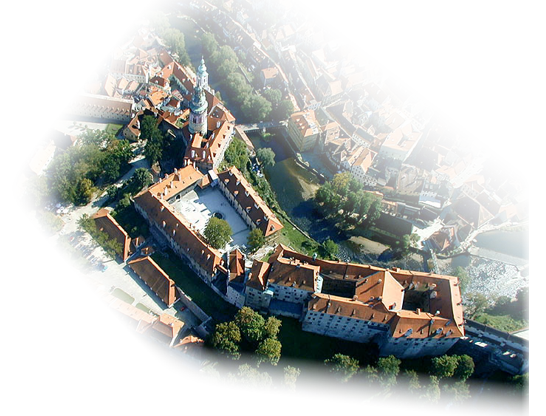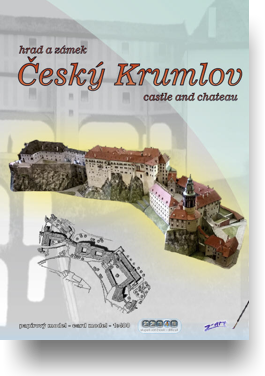

Český Krumlov is located in South Bohemia on Vltava River. The site has been populated since the Bronze Age thanks to its advantageous position by a trade route and location on a safe rock. The beginnings of the medieval settlement are proven by archaeological finds and the oldest written document comes from 1253. The oldest owners were the Lords of Krumlov, followed by the Vítkov family and then Rožmberk (Rosenberg) family. Their coat of arms sign was a five-petal rose, which remains the sign of the town and chateau until today. In 1602, Petr Vok of Rožmbek sold to castle to the emperor Rudolf II, who gave it to Eggenberk family. From 1719 to 1947 the chateau belonged to the Schwarzenberg family. After WWII, it was confiscated by the Czechoslovak State and then it belonged to the Czech State. It has been a UNESCO Heritage Site since 1992.
The original Gothic castle was just a very small castle with a tower, called Hrádek. During Peter of Rozmberk era, the Upper Castle (Horní hrad) with two mighty towers and and two palaces were built. There was a chapel, too. The entrance to the new part was probably a steep wooden ramp. In 14th century, a small forted town called Latran was built around the castle.
During 15th century, both palaces were improved, the chapel was re-built, a new courtyard surrounded by palaces was built. There were three floors of cellars under the surface level. There wasn´t a new tower, but the walls were up to five meters thick to defend the castle. Also, a new part of the castle with service buildings and entrance protection was built. There was a shield wall, too. Later on, the castle did not need massive protection and was gradually re-built into a chateau with representative and aesthetic elements.
The Rožmberk family gave the chateau a unique look of a noble residence. The chateau became a significant centre of social and art life. During the Eggenberk reign, a unique Baroque theatre was built on the fifth courtyard. Also during the Schwarzenberg family era, there were many improvements made, this time in rococo style. The interior, building and garden architecture have stayed approximately the same until today.
The Cloak Bridge was built in 17-18th Century and is passable through three floors and two connecting passageways, decorated with pillars and statues. The lower one connects the Masquerade Hall with the theatre, the upper one connects the paintings gallery with the garden and continues further into the cloister in Latran.
During the WWII and the following nationalization, the social function of the castle was suppressed, however after the Revolution in 1989, Český Krumlov regained its fame. It is one of the most significant tourist spots in the Czech Republic. You can take a guided tour in the chateau or explore the exteriors, gardens and town on your own.
 Český Krumlov 01 |
 Český Krumlov 02 |
 Český Krumlov 03 |
 Český Krumlov 04 |
 Český Krumlov 05 |
 Český Krumlov 06 |
 Český Krumlov 07 |
 Český Krumlov 08 |
 Český Krumlov 09 |
Model made by our customer (Thomas Tepel):
 Český Krumlov 10 |
 Český Krumlov 11 |
 Český Krumlov 12 |
 Český Krumlov 13 |
 Český Krumlov 14 |
 Český Krumlov 15 |
 Český Krumlov 16 |
 Český Krumlov 17 |
 Český Krumlov 18 |
 Český Krumlov 19 |
You can order in our e-shop.
Back


